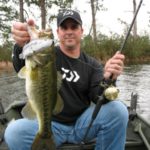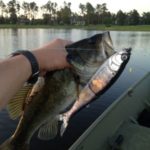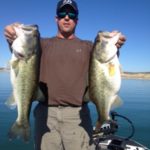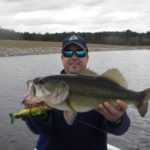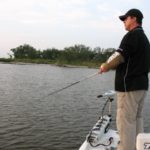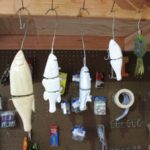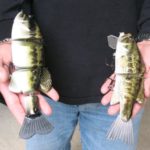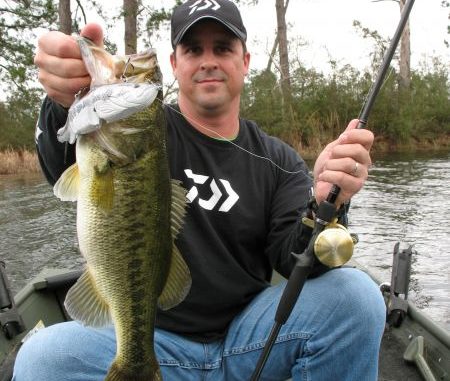
Think a 6-inch topwater is a big lure? You should check out the massive lures this Chalmette angler uses to catch monster bass, along with reds and trout.
The thought was first planted in Mike Herrmann’s mind back a few years ago while on a bass-fishing trip. It was one of those occasions when something important happened, something that rang an inner bell and registered deep in his memory, only to have that memory fall asleep until another similar incident awakened it.
But let me not get ahead of myself.
A few years ago, Mike Herrmann was doing something he did quite frequently: He was bass fishing.
A life-long bass angler, he often fished alone after work or in the early mornings before work. On one of those occasions he hooked a small bass and reeled it alongside the boat.
But instead of lifting the fish immediately into the boat as he usually did, he allowed it to dangle and splash around on the surface for a few moments.
And a huge bass pounced on the hapless fish and inhaled it right in front of him.
The big bass ran and jumped like bass do, and Herrmann opened his reel’s bail, hoping the big fish would actually swallow the smaller fish so he could reel it in.
But that didn’t happen; the small bass popped out of the mouth of the big fish, and still on his hook and still alive, Herrmann reeled it in.
The big bass — a fish he estimated to be at least 8 pounds — disappeared.
When he measured the small bass, it was every bit of 13 inches long. He knew that he witnessed something significant, that a big bass would inhale such a large bait, especially when the largest baits he used were never over 6 inches long.
The biggest topwater lures average 5 to 6 inches long, and those are considered big baits. Often, anglers actually consider them too big to catch fish on.
As profound as that thought was, he filed it away in the back of his memory, where it lay dormant for years.
And then, something else happened that awakened that memory: He booked a fishing trip with a guide at Florida’s Lake Okeechobee.
Herrmann and his dad make yearly trips to special bass lakes, where they book a guide and do some fishing on their own, as well. On this particular trip, the guide used big, live shiners — between 6 to 10 inches long.
Huge baits by any standard, and the big bass ate them up.
That’s what awakened Herrmann’s previous memory of the big bass eating up the 13 inch bass, and he came home with an idea.
He knew where he could toss a cast net and catch some gizzard shad in the 8- to 10-inch range, which he did. He took those live baits bass fishing and caught some of the biggest bass of his life.
And that became his new routine — catch big shad for bait and use them to catch big bass. He said he often caught 3-pound bass on 12-inch live baits, so it wasn’t just the huge bass that devoured the big baits.
The routine worked great until he could no longer find the big shad for bait.
That’s when he decided to build his own artificial shad bait.
Since Herrmann was already an accomplished duck carver, and already had lots of woodworking tools and equipment, he designed a huge five-piece jointed shad that measured almost 9 inches long, and cut it out of a chunk of the tupelo gum wood he used for carving ducks.
He drilled small holes in the bottom of it, filling them with lead so the bait would sink fast and swim deep. He finished it off by painting it to resemble a big shad.
The lure was an immediate success, and he started catching 5- and 6-pound bass on the big lure. He said he caught so many big bass on the lure that fish literally tore it apart.
Herrmann was hooked.
He made two more big baits, but neither of them worked properly. They weren’t evenly balanced, so they didn’t float upright or swim naturally, and were relegated to what would become a pile of failures.
But he was undeterred and began doing some research into big swim baits, and found some extremely helpful Web sites such as www.swimbaitnation.com.
There he was introduced to anglers all over the world who were doing the same thing: catching huge bass, trophy fish, on giant home-made swim-baits.
The Web site was loaded with how-to videos and pictures of huge bass caught on the big baits. From there, he learned to use a different wood, and discovered hints for more-successful results.
Before long he’d built dozens of baits in numerous shapes and sizes, and he again started catching some big bass — consistently.
“The challenge,” Herrmann said, “is to put together a bait that does what you want it to, whether you’re building a topwater bait or a swim bait. It can’t be unbalanced or it’ll either float sideways or the nose or the tail will sink too low, and of course everything you put into the bait affects it.
“The kind of wood you use affects it; if it’s jointed, the hardware affects it; the size of the hooks and eyes you use affect it; even the paint and clear-coat affects performance.
“The joints have to move freely enough to allow the bait to move naturally in the water, but if the joints are too loose that affects the action, also.”
Ballast has to be positioned with equal care.
“I use lead in the bottom (of the lure) to keep it floating upright, but you have to place it carefully to make sure the bait floats evenly,” Herrmann said. “It’s a lot of trial-and-error, but the thrill of catching a big fish on a swim bait you made yourself makes it worth the effort.”
The time involved in making a bait?
“From start to finish, you might put in five or six hours on a bait, or on a more complex multi-jointed bait as much as 10 to 12 hours, but you spread it out over the course of days or even weeks,” said Herrmann. “Things have to sit up and dry, etc.
“It becomes a hobby in itself, and you challenge yourself to do better each time, adding additional detail, modifying shapes and sizes, trying new colors and patterns.”
He said the Internet is a great resource for any lure builder.
“I’ll explore the Web to see what others are building and what success they’re having, and I’ll try that, modifying it to my own use.
“It’s a blast.”
And it’s a huge trend among trophy bass hunters all over the world. Japanese anglers have been extremely successful with the big swim baits, and in California’s trophy lakes many real hawgs — fish 15 pounds and over — have fallen victim to them.
It’s common sense, really. Big fish will readily eat small baits, but it takes a lot of small fish to satisfy the appetite of a big predator bass. And chasing small baits expends a lot of energy.
That’s why the temptation of a big, slow-moving bait is irresistible. In one big gulp a fish can satisfy its immediate hunger and spend the rest of the day digesting it instead of hunting for more.
Presentation is key to being successful, however. Herrmann said, the key is to toss the big baits in the likely spots where big bass lurk, and work them slowly back toward the boat.
Don’t rush it. Let them do the work, stirring the surface and making the commotion.
Work an area over thoroughly, and if they’re there, the big hunters will find them, he said.
